Dreams of a theory of everything
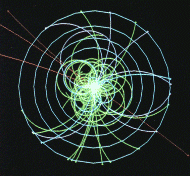 |
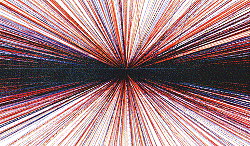 |
A view of discoveries still to be made
A computer simulation (above) of what scientists at CERN hope to see in the
(so far unbuilt) giant LHC - the fabled Higgs boson, a particle that should
exist at high energies, disintegrating into four muons (red). By colliding
heavy nuclei (right) in a separate experiment, the LHC would simulate the
era during which the universe was a primordial cosmic soup of quarks and
gluons |
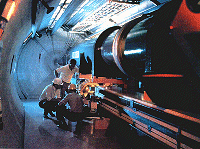 |
The highest energy ever Scientists (left)
work on a model of the new particle machine they hope to build at CERN. The
more powerful LHC would piggyback on the existing huge LEP collider, following
its circumference but working at much higher energies |
Could an ultimate equation that will explain the whole of creation be
just around the corner
The Standard Model has been extremely successful in revealing fundamental
patterns in nature. Like all ideas in physics, it is written in the language
of mathematics. One of its most powerful approaches is
symmetry - for example, changing a plus for a
minus in an equation governing the conservation of momentum or electric
charge.
When applied to quantum physics, ideas such as this led to the discovery
of antimatter. In antimatter each property of a particle, such as charge
and spin, is changed to its opposite. Antimatter is rather like looking at
ordinary matter through a special kind of mirror. Theorists are constantly
looking for other underlying symmetries, or mirrors, to try to understand
better the relationships between particles and forces - but still they have
a long way to go.
Although the Standard Model of particles seems to be confirmed by experiments
at CERN, there are a lot of unanswered questions. First, the top quark hasn't
been found yet (though indirect evidence indicates that it probably has a
mass of about 1600eV).
Secondly, theorists haven't a clue why there are the number of quarks and
leptons that there are, nor why their masses are so different, nor why they
have mass at all. In fact, what is mass? On the everyday scale you can describe
it as the amount of matter in something, but for individual particles it's
more like "concentrated energy" - as defined by Einstein's equation
E=mc2.
One theorist, Peter Higgs of Edinburgh University, suggested a new property
called the Higgs field, which would give the other particles mass through
interactions with a particle called the Higgs boson. Other theorists liked
the idea because it fitted in mathematically with the Standard Model. Physicists
are keen to find this particle, but its predicted mass (up to 10000eV) is
probably too great to be found using a current accelerator.
Uniting the forces
Theorists know that at high enough temperatures or energies, the electromagnetic
and the weak forces meld into a single "electroweak" force. They also think
that at even greater energies, the strong force unifies with the electroweak
force. There are a number of candidate so-called grand unified theories,
or GUTs, to explain how this might be.
One approach that could be successful is "supersymmetry", which seeks to
show a relationship between matter particles and force particles in terms
of their spin. It also suggests a whole new set of particles to look for,
because each normal particle would have a supersymmetrical partner. Again,
none of these particles has been found, although recent experiments suggest
that they might found at energies of about 1000GeV.
These questions cannot be resolved without building an even more powerful
accelerator - and this is exactly what the physicists at CERN want to do.
By causing proton beams to collide, the Large Hadron Collider (LHC) will
achieve energies of 16 TeV, which is greater than LEP. They aim to keep the
cost of the £1 billion-plus accelerator down by building it in the same
underground tunnel as LEP.
This is a nail-biting time for particle physicists. The 19 European countries
that fund CERN are deciding whether to give the go-ahead for the LHC. Late
last year, the Americans discontinued building an even more ambi tious venture,
the Superconducting Supercollider. Operating at 40 TeV, this would have
discovered a completely new regime of nature, scientists agree. But in the
end politicians decided that $12 billion was too high a price.
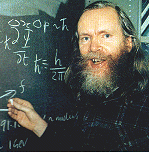 |
The wild man of physics
John Ellis, CERN's top theorist is out there at the frontier of physics.
His quarry is the ultimate theory that will explain everything - matter,
forces and the origin of the universe |
Particle physics and cosmology
Once the LHC has been built - and perhaps found the Higgs boson and some
supersymmetric particles - CERN will turn its attention to other mysteries.
One of the most interesting developments in physics over the past 30 years
is that experiments with the smallest particles have helped us to understand
the largest object we know of - the universe. Theorists think that just after
the Big Bang (at 10-43 seconds) all the forces of nature were
unified. Then, during the first ten-billionth of a second, quarks and leptons
formed, and the forces "froze out" as the temperature of the universe dropped
from 1032 to 1015 degrees.
The LHC will re-create these conditions and shed light on the early universe's
behaviour. One interesting experiment scientists are hoping to do is investigate
the epoch at 10-34 seconds, when quarks and gluons (the particles
that carry the strong force) existed separately in a sort of cosmic soup.
To do this they will need to collide heavy nuclei, for example those of lead
or sulphur.
A theory of everything
The ultimate aim of many theorists is to find a complete description of nature,
some simple mathematical equation that you could write on a T-shirt.
This "theory of everything" would refer to gravity in the same mathematical
form as the other forces - that of quantum theory. This would tie up all
the basic forces of the universe into one coherent system. So far, though,
there is no satisfactory theory of quantum gravity, but
"superstring theory" - in which particles
are regarded not as point-like objects but as modes of vibration on loops
of "string" - seems to bring gravity into the quantum regime.
Superstring theory could offer a way of at last unifying all the forces -
including gravity - satisfactorily, but so far the various approaches tried
have difficulties still to be resolved. However, to test such an idea would
require energies of 1019GeV - well beyond any terrestrial accelerator.
In fact, probably the only time these energies have ever been reached was
at the conception of the universe - the Big
Bang itself.
Nina Hall
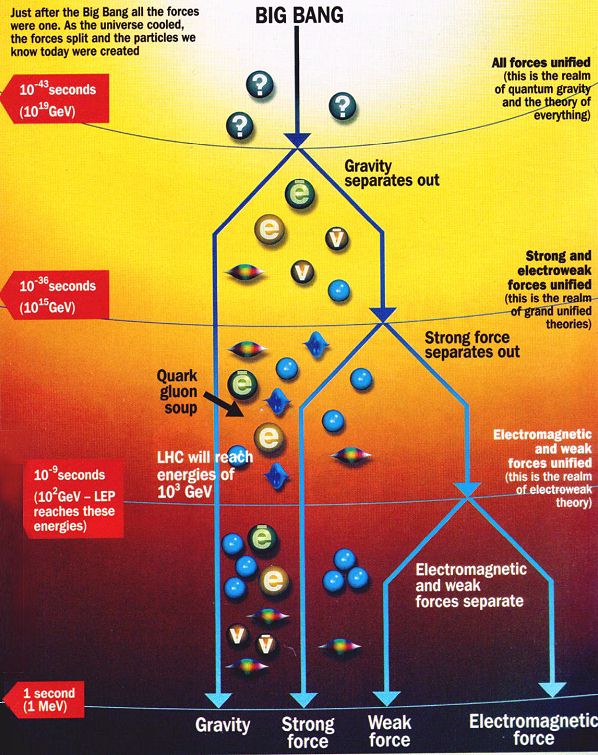 |
 Mar94 p58
Mar94 p58




